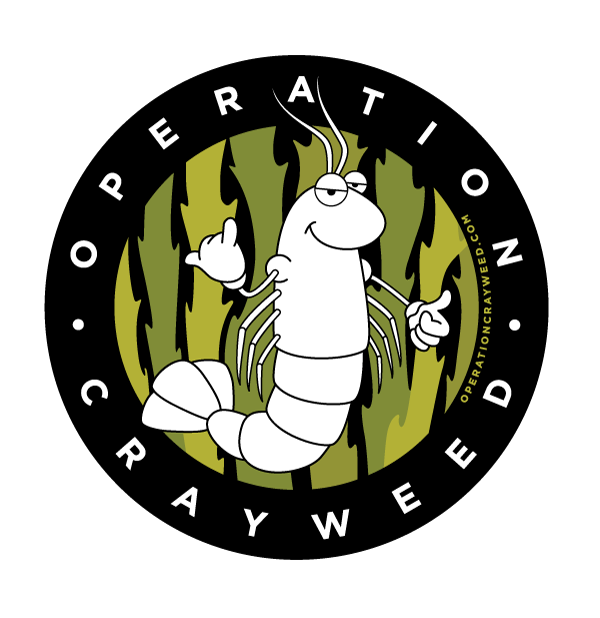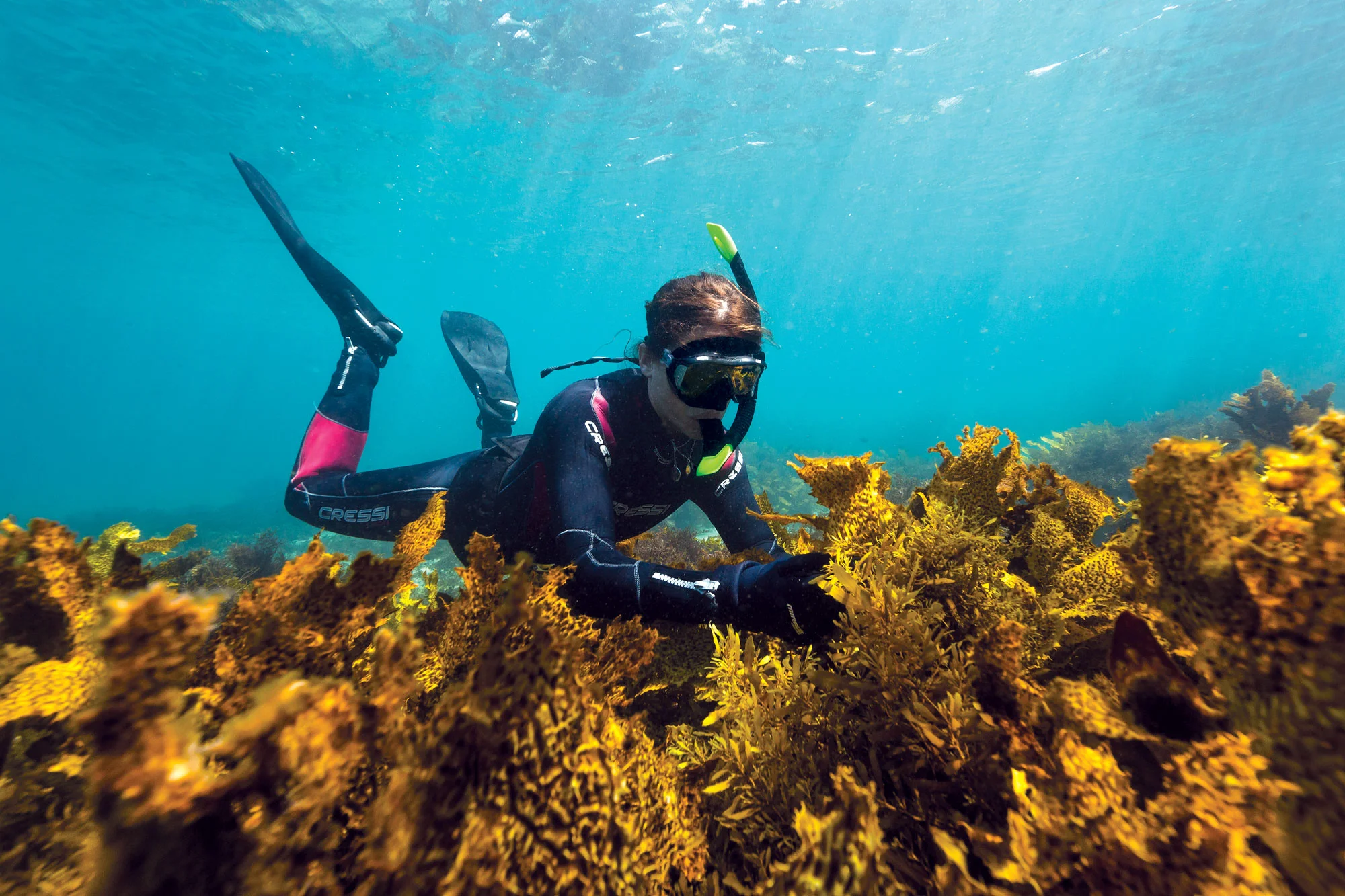Dr Claudia Santori
Claudia travelled from Italy to Australia in pursuit of her PhD at the University of Sydney in freshwater turtle ecology and conservation, which she completed in 2020. Since then, she has worked in marine natural resource management and environmental consulting. She is now a Project Coordinator at UNSW and the Sydney Institute of Marine Science working on Operation Crayweed, organising field work and outreach events.
Professor Adriana Vergés
Adriana is a marine ecologist based at UNSW Australia and the Sydney Institute of Marine Science. She leads the community engagement components of Operation Crayweed. Her research focuses on the ecology and conservation of algal forests, seagrass meadows and coral reefs. Besides being passionate about science and the underwater world, she is also very passionate about science communication and storytelling in all its forms.
Professor Melinda Coleman
Melinda is a Senior Principal Research Scientist with the NSW Department of Primary Industries and Regional Development, based at the National Marine Science Centre at Coffs Harbour. Melinda's current research centres on connectivity and population genetics of habitat-forming seaweeds, with a particular focus on the implications for their conservation, now and under future climate scenarios.
Dr Chanelle Webster
Chanelle has a passion for advocating for ‘marine underdogs’ which she considers to be the less charming but incredibly important ocean habitats including seagrass meadows and algal forests. As a marine scientist, she studies how the environment and people affect these habitats to improve their conservation. She enjoys challenging herself to become a better storyteller to communicate her science with the public.
Associate Professor Ezequiel Marzinelli
Ezequiel, aka Ziggy, leads the crayweed restoration research at the University of Sydney and the Sydney Institute of Marine Science. He is a marine ecologist who studies how interactions with marine creatures and microbes affect seaweed forests in natural and urban environments. His goal is to use this information to improve conservation and management practices, particularly ecological restoration.
Associate Professor Alexandra Campbell
Alex is fascinated by habitat-forming organisms such as seaweeds and things that eat, infect and live on them. She is also interested in how environmental change (e.g. due to ocean warming and pollution) influences these interactions. She is based at the University of the Sunshine Coast, and her background is in marine ecology, environmental microbiology and environmental science. Check our her own website here.
Jack Vitnell
Jack's background in marine project management makes him well-suited for his role as Project Coordinator. With significant experience at both Manly and Sydney Sea Life aquariums, overseeing operations at Seabin, and exploring the startup sector, Jack brings a very diverse skill set to the Operation Crayweed team. Outside of work, he can be found surfing, diving, climbing and sailing along Australia's east coast.
Catalina Musrri
Catalina is a PhD student based at the University of Sydney. She has a background in marine ecology and research on latitudinal gradients of trophic interactions. She is interested in the effects of humans and climate change on coastal ecosystems and kelp forests. Catalina’s PhD seeks to understand the responses of crayweed to climate change and find the most suitable individuals for restoration purposes.
Professor Peter Steinberg
Peter is a distinguished researcher with more than 165 international publications and multiple patents. He is a world-renowned seaweed expert and his research interests include seaweed ecology, diseases of marine organisms, biofouling and antifouling, bacterial biofilm biology, marine chemical ecology and biotechnology. He is an Emeritus Professor of Biology at UNSW Australia and Director of the Sydney Institute of Marine Science.
Past students & collaborators
Adam Camilleri - Adam finished his Honours degree with Operation Crayweed at UNSW in June 2017, and his work showed that the black sea urchin Centrostephanus rodgersii prefers eating kelp than crayweed, which is good news for our restoration project! He also investigated multiple mechanisms driving urchin feeding patterns.
Prof Brendan Kelaher - Brendan is a marine biologist with ~30 years field experience based at the National Marine Science Centre, Southern Cross University, Coffs Harbour. His main research aim is to understand processes that create, maintain and impact marine biodiversity. Brendan played a key role in quantifying the initial loss of crayweed and helped kick off the first restoration experiments and the launch of Operation Crayweed.
Clayton Mead - Clay finished his Honours at UNSW Sydney in 2020. His research focused on quantifying the costs of benefits of restoring underwater forests by removing sea urchins. He was a key member of the crayweed crew until 2023, when he moved on to work with an ecological consultancy.
Dr Damon Bolton - Damon loves all things marine and is nearly more comfortable underwater than out of it. He is an Associate lecturer at UNSW in environmental impact and natural resource management. His PhD research investigated how urban marine environments can alter predator-prey interactions.
Derrick Cruz - Derrick grew up snorkelling and exploring the estuaries and seagrass meadows of NSW. He is now a passionate fish ecologist and holds particular interests in range-shifting species, habitat restoration and the enhancement of wild fisheries. He has worked with DPI and UNSW on various field-intensive projects and enjoys promoting sustainable practices to younger generations. Derrick was a key member of the crayweed crew until early 2023, when he moved on to work with the NSW Government.
Dr Georgina Wood - George finished her crayweed-themed PhD at UNSW Sydney in 2020. Her research used genomics to guide our first scaled-up crayweed restoration efforts. She also investigated novel ways of using genomics to ‘future-proof’ our underwater forests, that is, to develop restoration solutions that consider not only our present environment but future expected conditions, which is becoming increasingly important as the world continues to change dramatically fast. George is also passionate about science communication and public outreach through direct outdoor experience and citizen science. After a stint working as a Postdoctoral Research Fellow at the University of Western Australia, she is now an Australian Research Council Early Career Industry Fellow at Flinders University, combining genomics, artificial intelligence and experimental ecology to develop guidelines and technologies that maximise the growth and resilience of key seaweed species for aquaculture.
Lana Kajlich - Lana’s PhD explored informed and innovative science communication via citizen science, education and the power of the arts. She is interested in exploring the links between the social and ecological with respect to the large-scale restoration of crayweed across Sydney. Her background is in both education and ecological restoration. She is also an avid fan of the marine diversity of Sydney.
Maddy Langley - Maddy is a PhD student at UNSW. She grew up exploring the beaches of the east coast, and continues to work, study, and play in the ocean wherever possible. She was a key part of the crayweed crew in the early 2020s and now continues to help the team from time to time.
Nigel Coombes - Nige finished his honours at UNSW in 2016, and did a series of super-challenging experiments in Cape Banks to work out whether herbivores can limit the success of our restoration efforts. Adam designed a set of 'herbivore-exclusion' cages using fish nets that stopped all big critters from eating our experimental crayweed mats. His thesis concluded that herbivory can indeed strongly influence restoration success and he identified both fish and urchins as responsible for eating crayweed.
Dr Tamsin Peters - Tamsin finished her PhD degree at UNSW in 2016, working on environmental stress and disease in crayweed. She has dived and sampled crayweed forests all the way from Port Macquarie in NSW to the depths of Tasmania. She is unmatched in her ability to tell apart male from female crayweed plants and was the first to describe an important fungal disease that affects high proportions of crayweed populations.
Contributors
Alicia Lloyd
Aquarist & Researcher
Claudette Rechtorik
Sea Life Trust Advisor
Steve Oliver
Film Director
Shannon Ruddock
Film Maker
Nige Coombes
Honours student @ UNSW
Tamsin Peters
Research associate @ UNSW
James Sherwood
Photographer and camera work
The Acid
Movie soundtrack
John Turnbull
Photographer www.marineexplorer.org
Justin Gilligan
Photographer
Berta Companys
Volunteer extraordinaire
Sophie Powell
Research Assistant
Banner image by James Sherwood










